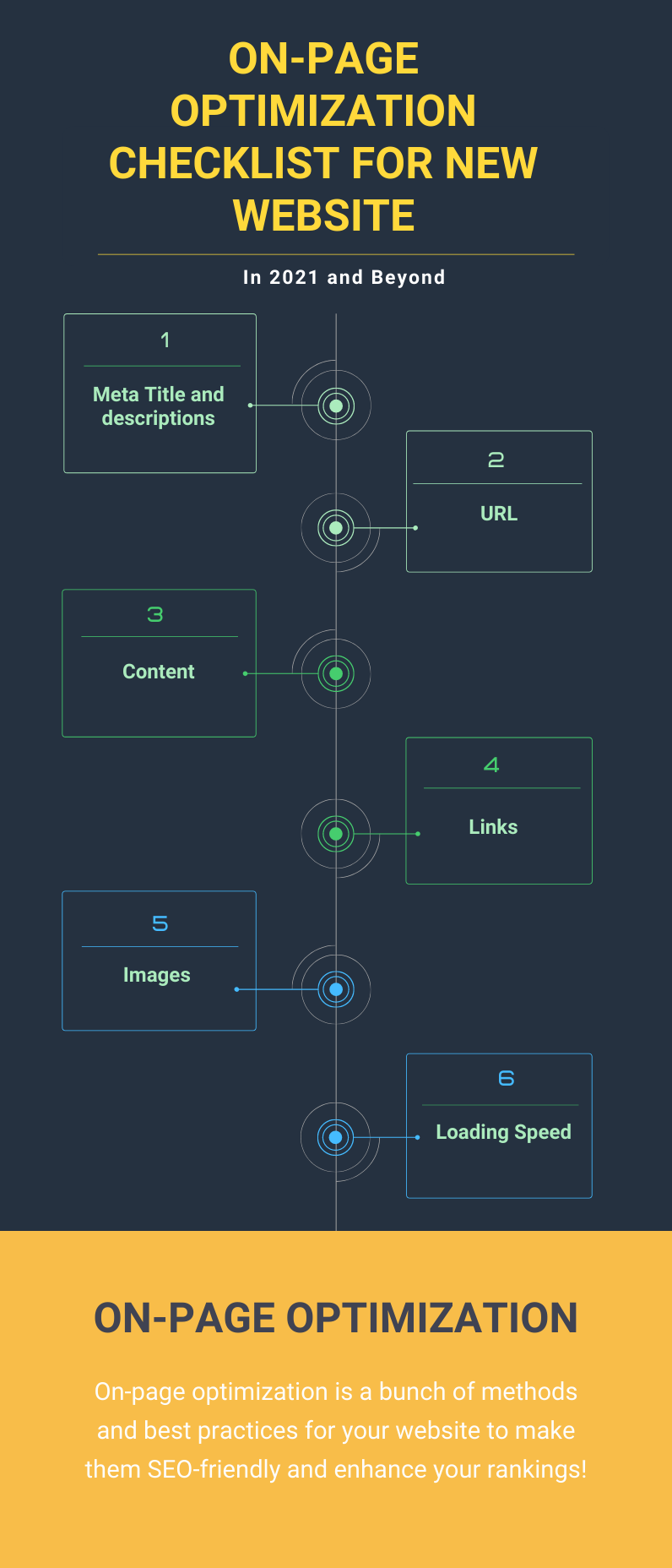On-page optimization is a bunch of methods and best practices for your website to make them SEO-friendly and enhance your rankings.
Today, as you know, SEO keywords are essential for on-page optimization. However, it involves a set of elements, not just SEO keywords. So, it’s easy to miss a few of them. To create it simple for you to make sure all your web pages have optimized for the top possible rankings.
Let’s take a glance at the on-page optimization checklist for a new website.

Meta Title and Descriptions
Check that you have added the main keywords of all web pages in front of the meta title tags.
Check the title tag’s length is 60-65 characters. Otherwise, it might get cut in the SERPs.
Meta title must be the only thing covered in the H1 tag. In other words, only one H1 heading tag per web page has restrained the title.
Check you have written a welcoming and keyword-rich meta description. It must suit the search intent of your users. Make it under 160 characters for all pages.
URL
To make sure URLs are concise rather than complex and lengthy. Shorter URLs are inclined to have decent CTR and are understood by crawlers easily.
Add your page’s primary keyword in the URL, avoid filler words (like to, for, the), and fix it under 60 characters.
Content
All your website and blog content play a vital role in on-page SEO. Besides ensuring your primary keywords are natural throughout your URL, content title, subheadings, and paras. Here are two things to get right.
- Content Structure
Check the content structure on all web pages. Ensure you have added keyword-optimized headings and subheadings, and more, to create a logical form that improves the crawling and readability of your content.
- Content Comprehensiveness
When it comes to SEO rankings, in-depth and lengthy posts will work better than shorter ones so, strive to have a 1500-2000 word count in content. Long-term and unique content will serve your target users better as they are likely to reply to all their queries about the niche, so they need not search for more posts.
Links
Make sure you have the proper linking techniques that you should follow. Internal and external links play a pivotal role in your on-page optimization checklist.
- Internal Links
Ensure properly interlink content and web pages on your site. It helps crawlers to rank your content for the primary keywords. Also, internal linking will help readers to appropriate pages and keep them engaged.
- External Links
Having outbound links and citing external sources is for developing credibility with readers and Google crawlers. Ensure that you are linking back to reliable sources and high-quality websites.
Moreover, make sure there are no broken links as they affect user experience and SEO. If you may have more website pages, it is better to make them engaging. It will help you keep readers and assist them in searching for relevant content.
Images
Your site is likely running with images, which is fair as image plays significantly to enhance both rankings and user experience. They create your content more engaging, easy to understand, and memorable, and help you get more traffic to your site. To improve your images for on-page optimization, below are the things to make sure,
- Image File Size
Lots of images slow down your website’s page load speed. Load speed is a key ranking factor for both mobile and desktop searches. So, ensure to make a compressed and reduced image size (preferably under 70 kb).
- Image Filename
In general, Google bots can’t ‘view’ images like humans. They need the following text to comprehend what the image is all about. Better write a descriptive filename for those images on your website, including keywords.
- Image Alt Text
Also, alt text helps make your site more flexible and accessible, as visitors use this to describe images. It is good to test your site’s accessibility. It helps if the images fail to load for any other reason.
For example – Use green-forest.jpg instead of 12345.jpg.
Page Load Speed
Loading speed is the main ranking factor you can’t afford to miss. If pages take over 2-3 seconds to load means, your page readers will back to a competitor, and reaching first page rankings will stay just a dream. So, check that,
- Optimal server response time
- Optimized code
- Compressed images
- Enable browser caching and file compression
- Eliminate unwanted redirects
Audit your website speed with the help of Page Speed Insights to check out the exact areas.
Final Touch
With every new update to its algorithm, Google is quickly moving its focus on rewarding sites with a better user experience. The above-mentioned on-page optimization checklists help you achieve top Google rankings and remain there. Moreover, keep these on-page optimization checklists as you work on your marketing and beyond.
Read More:
How To Write SEO-Friendly Content For Websites?
Beginners Guide: SEO Checklist for New Website












